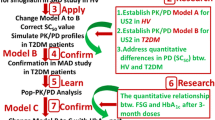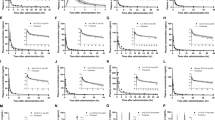Abstract
Aim
The objective of this study was to develop a physiologically based pharmacokinetic (PBPK) model for sinogliatin (HMS-5552, dorzagliatin) by integrating allometric scaling (AS), in vitro to in vivo exploration (IVIVE), and steady-state concentration–mean residence time (Css-MRT) methods and to provide mechanistic insight into its pharmacokinetic properties in humans.
Methods
Human major pharmacokinetic parameters were analyzed using AS, IVIVE, and Css-MRT methods with available preclinical in vitro and in vivo data to understand sinogliatin drug metabolism and pharmacokinetic (DMPK) characteristics and underlying mechanisms. On this basis, an initial mechanistic PBPK model of sinogliatin was developed. The initial PBPK model was verified using observed data from a single ascending dose (SAD) study and further optimized with various strategies. The final model was validated by simulating sinogliatin pharmacokinetics under a fed condition. The validated model was applied to support a clinical drug–drug interaction (DDI) study design and to evaluate the effects of intrinsic (hepatic cirrhosis, genetic) factors on drug exposure.
Results
The two-species scaling method using rat and dog data (TS-rat,dog) was the best AS method in predicting human systemic clearance in the central compartment (CL). The IVIVE method confirmed that sinogliatin was predominantly metabolized by cytochrome P450 (CYP) 3A4. The Css-MRT method suggested dog pharmacokinetic profiles were more similar to human pharmacokinetic profiles. The estimated CL using the AS and IVIVE approaches was within 1.5-fold of that observed. The Css-MRT method in dogs also provided acceptable prediction of human pharmacokinetic characteristics. For the PBPK approach, the 90% confidence intervals (CIs) of the simulated maximum concentration (Cmax), CL, and area under the plasma concentration–time curve (AUC) of sinogliatin were within those observed and the 90% CI of simulated time to Cmax (tmax) was closed to that observed for a dose range of 5–50 mg in the SAD study. The final PBPK model was validated by simulating sinogliatin pharmacokinetics with food. The 90% CIs of the simulated Cmax, CL, and AUC values for sinogliatin were within those observed and the 90% CI of the simulated tmax was partially within that observed for the dose range of 25–200 mg in the multiple ascending dose (MAD) study. This PBPK model selected a final clinical DDI study design with itraconazole from four potential designs and also evaluated the effects of intrinsic (hepatic cirrhosis, genetic) factors on drug exposure.
Conclusions
Sinogliatin pharmacokinetic properties were mechanistically understood by integrating all four methods and a mechanistic PBPK model was successfully developed and validated using clinical data. This PBPK model was applied to support the development of sinogliatin.




Similar content being viewed by others
Abbreviations
- AS:
-
Allometric scaling
- AUC:
-
Area under the curve
- BP:
-
Blood plasma ratio
- BW:
-
Body weight
- CI:
-
90% confidence interval
- CL:
-
Systemic clearance in central compartment
- CL/F:
-
Clearance after oral administration
- CLh:
-
Hepatic clearance
- CLint:
-
Intrinsic clearance
- CLiv:
-
Clearance after intravenous administration
- C max :
-
Peak concentration
- CLr:
-
Renal clearance
- C ss-MRT:
-
Steady-state concentration- mean residence time
- DDI:
-
Drug–drug interactions
- ER:
-
Excretion ratio
- F a :
-
Absorbed fraction
- F :
-
Bioavailability
- FASSIF:
-
Fasted state simulated intestinal fluid
- FESSIF:
-
Fed state simulated intestinal fluid
- FIH:
-
First in human
- F sc :
-
Scaling factor between observed and predicted data
- GK:
-
Glucokinase
- GKA:
-
Glucokinase activator
- H :
-
Hematocrit
- HLM:
-
Human liver microsomes
- IVIVE:
-
In vitro to in vivo exploration
- K a :
-
Absorption rate constant
- K m :
-
Michelis–Menten constant
- MPPGL:
-
mg protein per liver weight
- MRT:
-
Mean residence time
- M.W:
-
Molecular weight
- OATP:
-
Organic anion transporting polypeptide
- Obs:
-
Observed values
- P app :
-
Apparent permeability coefficient
- P eff :
-
Jejunum effective permeability
- P-gp:
-
P-Glycoprotein
- PK:
-
Pharmacokinetics
- PBPK:
-
Physiologically based pharmacokinetic
- rhCYP:
-
Recombinant human cytochrome P450 enzyme
- SAS:
-
Simple allometric scaling method
- Sim:
-
Simulated values
- SGF:
-
Simulated gastric fluid
- SSS:
-
Single species scaling method
- T2DM:
-
Type 2 diabetic patients
- T max :
-
Time at the peak concentration occurs
- V c :
-
Distribution volume of central compartment
- TS:
-
Two species scaling method
- V d :
-
Distribution volume of peripheral compartment
- V max :
-
Enzyme maximum rate of metabolite formation
- V ss :
-
Steady-state distribution volume
References
Olokoba AB, Obateru OA, Olokoba LB. Type 2 diabetes mellitus: a review of current trends. Oman Med J. 2012;27(4):269–73. https://doi.org/10.5001/omj.2012.68.
Inzucchi SE, Bergenstal RM, Buse JB, Diamant M, Ferrannini E, Nauck M, et al. Management of hyperglycemia in type 2 diabetes, 2015: a patient-centered approach: update to a position statement of the American Diabetes Association and the European Association for the Study of Diabetes. Diabetes Care. 2015;38(1):140–9. https://doi.org/10.2337/dc14-2441.
Grewal AS, Sekhon BS, Lather V. Recent updates on glucokinase activators for the treatment of type 2 diabetes mellitus. Mini Rev Med Chem. 2014;14(7):585–602.
Filipski KJ, Pfefferkorn JA. A patent review of glucokinase activators and disruptors of the glucokinase–glucokinase regulatory protein interaction: 2011-2014. Expert Opin Ther Pat. 2014;24(8):875–91. https://doi.org/10.1517/13543776.2014.918957.
Anderka O, Boyken J, Aschenbach U, Batzer A, Boscheinen O, Schmoll D. Biophysical characterization of the interaction between hepatic glucokinase and its regulatory protein: impact of physiological and pharmacological effectors. J Biol Chem. 2008;283(46):31333–40. https://doi.org/10.1074/jbc.M805434200.
Grimsby J, Sarabu R, Corbett WL, Haynes NE, Bizzarro FT, Coffey JW, et al. Allosteric activators of glucokinase: potential role in diabetes therapy. Science. 2003;301(5631):370–3. https://doi.org/10.1126/science.1084073.
Xu H, Sheng L, Chen W, Yuan F, Yang M, Li H, et al. Safety, tolerability, pharmacokinetics, and pharmacodynamics of novel glucokinase activator HMS5552: results from a first-in-human single ascending dose study. Drug Des Dev Ther. 2016;10:1619–26. https://doi.org/10.2147/dddt.s105021.
Oie S, Tozer TN. Effect of altered plasma protein binding on apparent volume of distribution. J Pharm Sci. 1979;68(9):1203–5.
Perrier D, Gibaldi M. Clearance and biologic half-life as indices of intrinsic hepatic metabolism. J Pharmacol Exp Ther. 1974;191(1):17–24.
Van den Bergh A, Sinha V, Gilissen R, Straetemans R, Wuyts K, Morrison D, et al. Prediction of human oral plasma concentration-time profiles using preclinical data: comparative evaluation of prediction approaches in early pharmaceutical discovery. Clin Pharmacokinet. 2011;50(8):505–17. https://doi.org/10.2165/11587230-000000000-00000.
Rostami-Hodjegan A. Physiologically based pharmacokinetics joined with in vitro-in vivo extrapolation of ADME: a marriage under the arch of systems pharmacology. Clin Pharmacol Ther. 2012;92(1):50–61. https://doi.org/10.1038/clpt.2012.65.
Xia B, Heimbach T, Lin TH, He H, Wang Y, Tan E. Novel physiologically based pharmacokinetic modeling of patupilone for human pharmacokinetic predictions. Cancer Chemother Pharmacol. 2012;69(6):1567–82. https://doi.org/10.1007/s00280-012-1863-5.
Rodgers T, Rowland M. Mechanistic approaches to volume of distribution predictions: understanding the processes. Pharm Res. 2007;24(5):918–33. https://doi.org/10.1007/s11095-006-9210-3.
Guideline on the qualification and reporting of physiologically based pharmacokinetic (PBPK) modelling and simulation. European Medicines Agency. CHMP458101.2016. http://www.ema.europa.eu/docs/en_GB/document_library/Scientific_guideline/2016/07/WC500211315.pdf. Accessed 20 Mar 2018.
Maekawa K, Harakawa N, Yoshimura T, Kim SR, Fujimura Y, Aohara F, et al. CYP3A4*16 and CYP3A4*18 alleles found in East Asians exhibit differential catalytic activities for seven CYP3A4 substrate drugs. Drug Metab Dispos. 2010;38(12):2100–4. https://doi.org/10.1124/dmd.110.034140.
Liu D, Song H, Song L, Liu Y, Cao Y, Jiang J, et al. A unified strategy in selection of the best allometric scaling methods to predict human clearance based on drug disposition pathway. Xenobiotica. 2016;46(12):1105–11. https://doi.org/10.1080/00498254.2016.1205761.
Gao ZW, Zhu YT, Yu MM, Zan B, Liu J, Zhang YF, et al. Preclinical pharmacokinetics of TPN729MA, a novel PDE5 inhibitor, and prediction of its human pharmacokinetics using a PBPK model. Acta Pharmacol Sin. 2015;36(12):1528–36. https://doi.org/10.1038/aps.2015.118.
Zhuang X, Lu C. PBPK modeling and simulation in drug research and development. Acta Pharm Sin B. 2016;6(5):430–40. https://doi.org/10.1016/j.apsb.2016.04.004.
Liu F, Zhuang X, Yang C, Li Z, Xiong S, Zhang Z, et al. Characterization of preclinical in vitro and in vivo ADME properties and prediction of human PK using a physiologically based pharmacokinetic model for YQA-14, a new dopamine D3 receptor antagonist candidate for treatment of drug addiction. Biopharm Drug Dispos. 2014;35(5):296–307. https://doi.org/10.1002/bdd.1897.
Fotaki N, Gray V, Krämer J, Diaz D, Flanagan T, Grove G. Dissolution highlights from the 2015 AAPS Annual Meeting in Orlando. Dissolut Technol. 2016;23(2):42–7. https://doi.org/10.14227/dt230216p42.
Barter ZE, Bayliss MK, Beaune PH, Boobis AR, Carlile DJ, Edwards RJ, et al. Scaling factors for the extrapolation of in vivo metabolic drug clearance from in vitro data: reaching a consensus on values of human microsomal protein and hepatocellularity per gram of liver. Curr Drug Metab. 2007;8(1):33–45.
Gabrielsson JL, Groth T. An extended physiological pharmacokinetic model of methadone disposition in the rat: validation and sensitivity analysis. J Pharmacokinet Biopharm. 1988;16(2):183–201.
Clinical drug interaction studies: study design, data analysis, and clinical implications guidance for industry. US Food and Drug Administration, CDER; 2017. https://www.fda.gov/downloads/drugs/guidancecomplianceregulatoryinformation/guidances/ucm292362.pdf. Accessed 20 Mar 2018.
Mano Y, Sugiyama Y, Ito K. Use of a physiologically based pharmacokinetic model for quantitative prediction of drug–drug interactions via CYP3A4 and estimation of the intestinal availability of CYP3A4 substrates. J Pharmaceut Sci. 2015;104(9):3183–93. https://doi.org/10.1002/jps.24495.
Vieira ML, Zhao P, Berglund EG, Reynolds KS, Zhang L, Lesko LJ, et al. Predicting drug interaction potential with a physiologically based pharmacokinetic model: a case study of telithromycin, a time-dependent CYP3A inhibitor. Clin Pharmacol Ther. 2012;91(4):700–8. https://doi.org/10.1038/clpt.2011.305.
Pettit NN, Pisano J, Weber S, Ridgway J. Hepatic failure in a patient receiving itraconazole for pulmonary histoplasmosis—case report and literature review. Am J Ther. 2016;23(5):e1215–21. https://doi.org/10.1097/mjt.0000000000000313.
Edginton AN, Willmann S. Physiology-based simulations of a pathological condition: prediction of pharmacokinetics in patients with liver cirrhosis. Clin Pharmacokinet. 2008;47(11):743–52. https://doi.org/10.2165/00003088-200847110-00005.
Johnson TN, Boussery K, Rowland-Yeo K, Tucker GT, Rostami-Hodjegan A. A semi-mechanistic model to predict the effects of liver cirrhosis on drug clearance. Clin Pharmacokinet. 2010;49(3):189–206. https://doi.org/10.2165/11318160-000000000-00000.
Zhao P, Vieira Mde L, Grillo JA, Song P, Wu TC, Zheng JH, et al. Evaluation of exposure change of nonrenally eliminated drugs in patients with chronic kidney disease using physiologically based pharmacokinetic modeling and simulation. J Clin Pharmacol. 2012;52(1 Suppl):91s–108s. https://doi.org/10.1177/0091270011415528.
Fukushima-Uesaka H, Saito Y, Watanabe H, Shiseki K, Saeki M, Nakamura T, et al. Haplotypes of CYP3A4 and their close linkage with CYP3A5 haplotypes in a Japanese population. Hum Mutat. 2004;23(1):100. https://doi.org/10.1002/humu.9210.
D’Argenio DZ, Schumitzky A, Wang X. ADAPT 5 user’s guide: pharmacokinetic/pharmacodynamic systems analysis software. Los Angeles: Biomed Simulations Resource; 2009. https://bmsr.usc.edu/software/adapt/citations/
Barter ZE, Tucker GT, Rowland-Yeo K. Differences in cytochrome p450-mediated pharmacokinetics between Chinese and Caucasian populations predicted by mechanistic physiologically based pharmacokinetic modelling. Clin Pharmacokinet. 2013;52(12):1085–100. https://doi.org/10.1007/s40262-013-0089-y.
Crewe HK, Barter ZE, Yeo KR, Rostami-Hodjegan A. Are there differences in the catalytic activity per unit enzyme of recombinantly expressed and human liver microsomal cytochrome P450 2C9? A systematic investigation into inter-system extrapolation factors. Biopharm Drug Dispos. 2011;32(6):303–18. https://doi.org/10.1002/bdd.760.
Brown RP, Delp MD, Lindstedt SL, Rhomberg LR, Beliles RP. Physiological parameter values for physiologically based pharmacokinetic models. Toxicol Ind Health. 1997;13(4):407–84. https://doi.org/10.1177/074823379701300401.
Davies B, Morris T. Physiological parameters in laboratory animals and humans. Pharm Res. 1993;10(7):1093–5.
Acknowledgements
We acknowledge Dr Bo Liu for his comments for the SimCYP® software technology support.
Funding
This study was supported by the National Natural Science Foundation of China (Nos. 81403013 and 81403015) and the ‘13th Five-Year’ National Major New Drug Projects (Nos. 2017ZX09101001-002-001 and 2017ZX09304031-001).
Author information
Authors and Affiliations
Corresponding authors
Ethics declarations
Conflict of interest
Yi Zhang, Shuang Ren, and Li Chen are employees of Hua Medicine (Shanghai) Ltd., the company developing sinogliatin. Ling Song, Ji Jiang, Dongyang Liu, Xijing Chen, and Pei Hu declare no conflicts of interest relevant to the contents of this manuscript.
Electronic supplementary material
Below is the link to the electronic supplementary material.
Rights and permissions
About this article
Cite this article
Song, L., Zhang, Y., Jiang, J. et al. Development of a Physiologically Based Pharmacokinetic Model for Sinogliatin, a First-in-Class Glucokinase Activator, by Integrating Allometric Scaling, In Vitro to In Vivo Exploration and Steady-State Concentration–Mean Residence Time Methods: Mechanistic Understanding of its Pharmacokinetics. Clin Pharmacokinet 57, 1307–1323 (2018). https://doi.org/10.1007/s40262-018-0631-z
Published:
Issue Date:
DOI: https://doi.org/10.1007/s40262-018-0631-z




